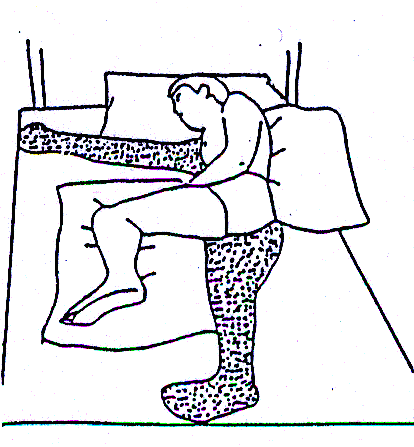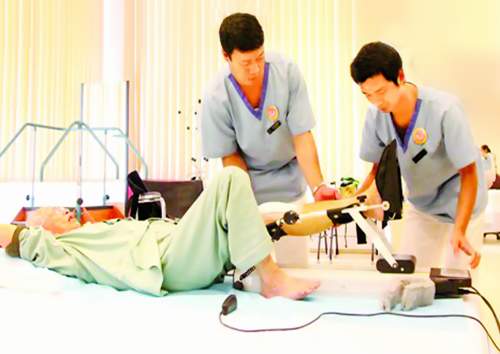Stroke is a common disorder abruptly stopped when the blood supply to
the brain, causing brain damaged area and leave the serious sequelae
such as hemiplegia, language disorder awareness, lisp and food spillage
... or can lead to death. There are two types of brain stroke: ischemic local (cerebral infarction) and cerebral hemorrhage (bleeding in the brain).
Stroke can occur in any age group but a high proportion of older people. Stroke Patients less will leave sequelae, one of the common sequelae such as hemiplegia. Patients with brain stroke hemiplegia often not take care of themselves, difficulties in living matter and daily exercise. So, how to recover quickly sequelae in patients with hemiplegia following stroke brain? It
is an important issue for patients to help patients can go back and
take care of yourself, integrated with family life and society.

Hemiplegia progresses through three stages
The first stage: Listing soft decrease muscle tone, lasting a few weeks.
Spastic phase: increased muscle tone, spasticity expression pattern:
* Top of the disease: in favor of the list, turn to the good side.
* Details on: Expression pattern rigidity than:
Shoulder blade is pulled back, the shoulder belt is pulled down.
Shoulder closed and rotated inward.
Folding elbow joint, forearm pronation.
Wrist joint surface than pleased and slightly tilted toward the ulna.
Thumb and other fingers folded and closed.
* Body: Tilt and rotate the side paralysis after.
* Details below: Expression pattern stretching spasticity:
Your hips are pulled up on the list and turn back.
Hip stretch, closed and rotated out.
Knee extensor. Ankle folded hand feel, feet inclined inwards, the folded and closed toes.
The last phase
(phase sequelae): increased muscle tone, sometimes leading to increased
rigidity while the patient's head would be on the list, return to the
good side; upper limb spasticity in the folded position, lower limb gait racket going with cloves.
- The associated symptoms: possible
+ Decrease or loss of feeling side of paralysis.
+
Display VII nerve ipsilateral to the side of the central list:
distorted mouth, drinking water, food or spilled on the side paralyzed,
no whistling, blowing fire.
Language disorders if hemisphere brain damage advantages: paralyzed right if right handed.
+ Some other symptoms: circular muscle disorders, disorders feeling paralyzed side of ...
Complications, the risk of being paralyzed by a stroke on brain
- Of pressure ulcers.
- Inset, spasticity, ectopic ossification.
- Osteoporosis, bone fractures.
- Thrombophlebitis, venous thrombosis.
- Bowel disorders.
Rehabilitative treatment sequelae hemiplegia due to cerebral vascular accident
Rehabilitation
- The first stage:
+ The technical position: Put the bed, the position is the correct form of recovery.
+ Tap Campaign passive side of paralysis:
Shoulder: Fold, stretching, Christmas, closed, turn in, external rotation
Elbow joint: Fold, stretching the elbow, pronation, rotate your forearm back.
Wrist joint: Fold, stretching, leaning in, wrist joint eversion.
The finger: Fold, stretching, form, closing the fingers.
Hip: Bend, stretch, shape, closed, turn in, external rotation.
Knee: Fold, stretching.
Hock joint: Fold, stretching.
Toes: Fold, stretch, shape, closed.
- Phase follows:
+ Tap according to range of motion: collective advocacy assistance, advocacy initiative.
+ Episode motor positions: lying, sitting, standing, or walking.
+ Tap campaign with aids.
+ Episode perform self-care activities (active treatment).
+ Practice saying, communication (with aphasia patients).
- Phase integration:
+ Advice for patients and families: prevention of sequelae and complications of recurrence.
+ Renovation of houses and surroundings to suit the patient.
+ The aids needed for this phase: travel assistance, domestic help, aid work ...
+
Join the community integration activities: support groups, associations
of people with disabilities, access to public services, community
activities.
+
Support for patients and families about the psychological after stroke:
there are irreversible function, patients become disabled.
+
Employment and income: the ability to continue their previous jobs, or
who have to learn a new craft or what activities generate income?

Sequelae after stroke which left patients campaigning hard to go back. To
reduce the sequelae and relapse prevention, upon returning home after
the emergency phase, patients still have to be cared for and treated
according to the special mode as follows:
Mode of living, exercise
In severe cases, patients are not self-advocacy, need some help from relatives. The state must help them change posture 4 hours / once to avoid the ulcer. As for dining, the cushion behind the patient to hold their positions in half lying, half-sitting.
For milder cases, depending on the level of cell paralysis, to set out a specific plan for patients with daily exercise. Try to give them maximum self, family support or assistance only when patients are unable to do. During exercise requires perseverance of both the patient and the instructor. This work should be continued even when the sequelae have been restored.
Diet
Need to ensure adequate diet and physical balance. Should take the form of soft food, easy to digest, such as porridge, soup, milk, fresh fruit juice. Diets use fats and stimulants (wine, beer, specialty tea, coffee); salt restriction.

Không có nhận xét nào:
Đăng nhận xét